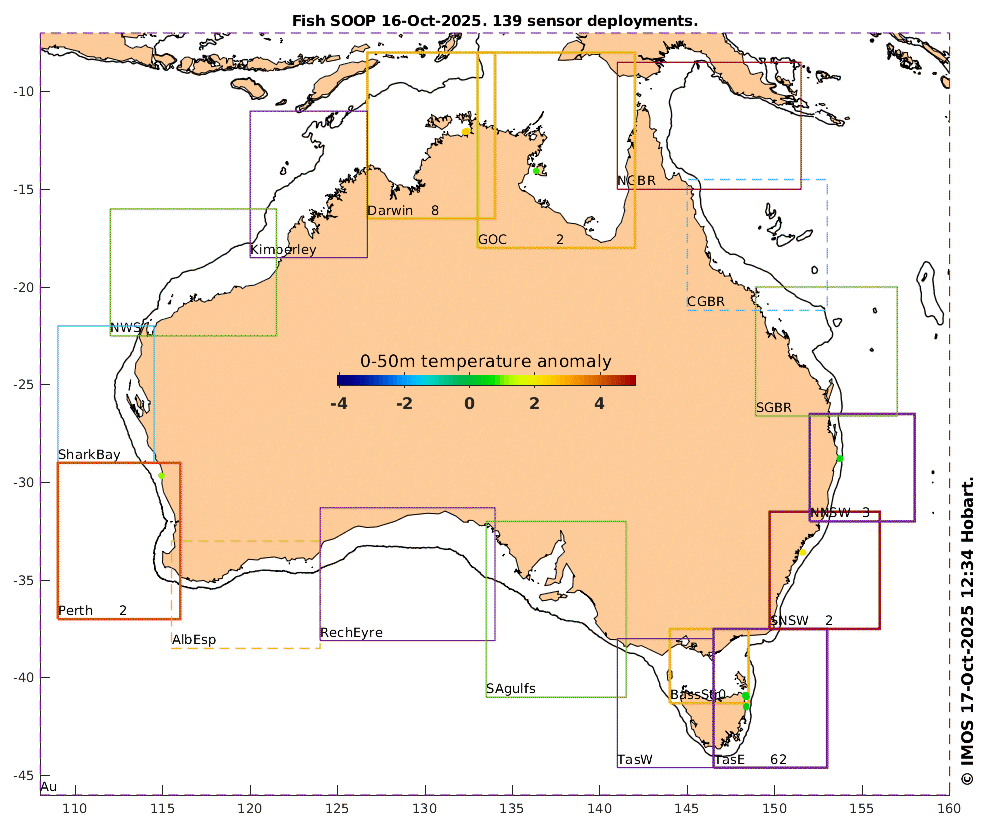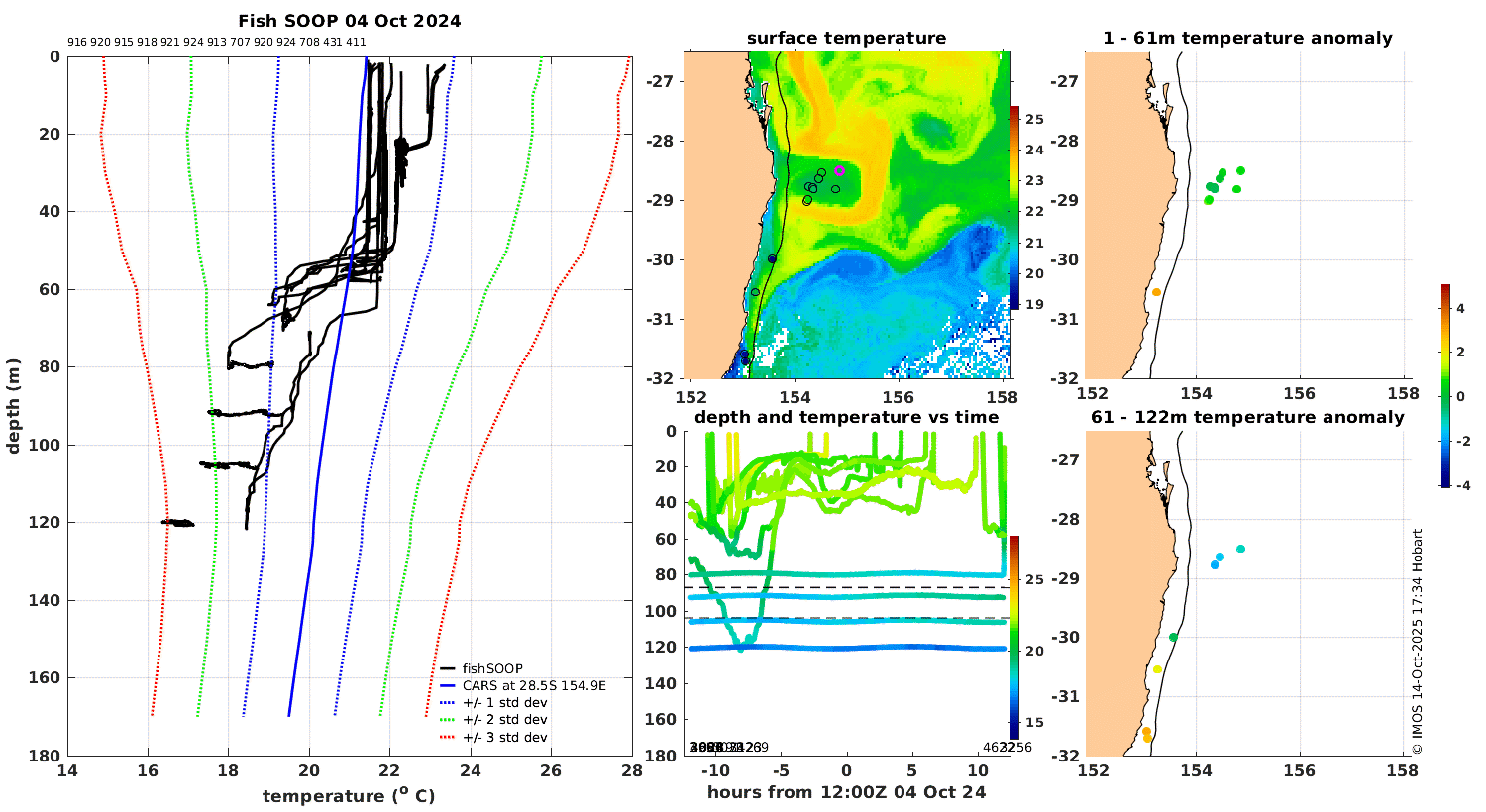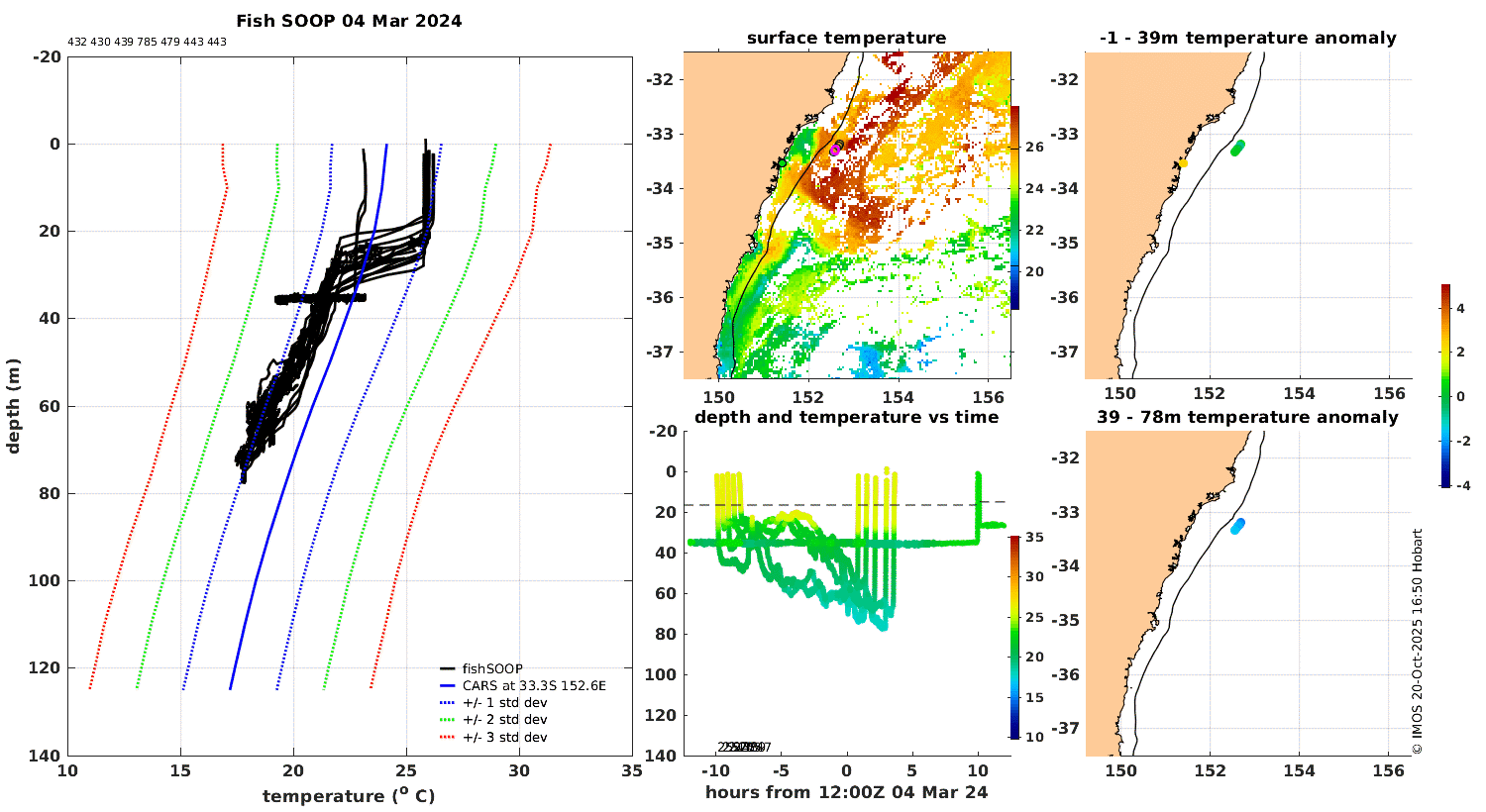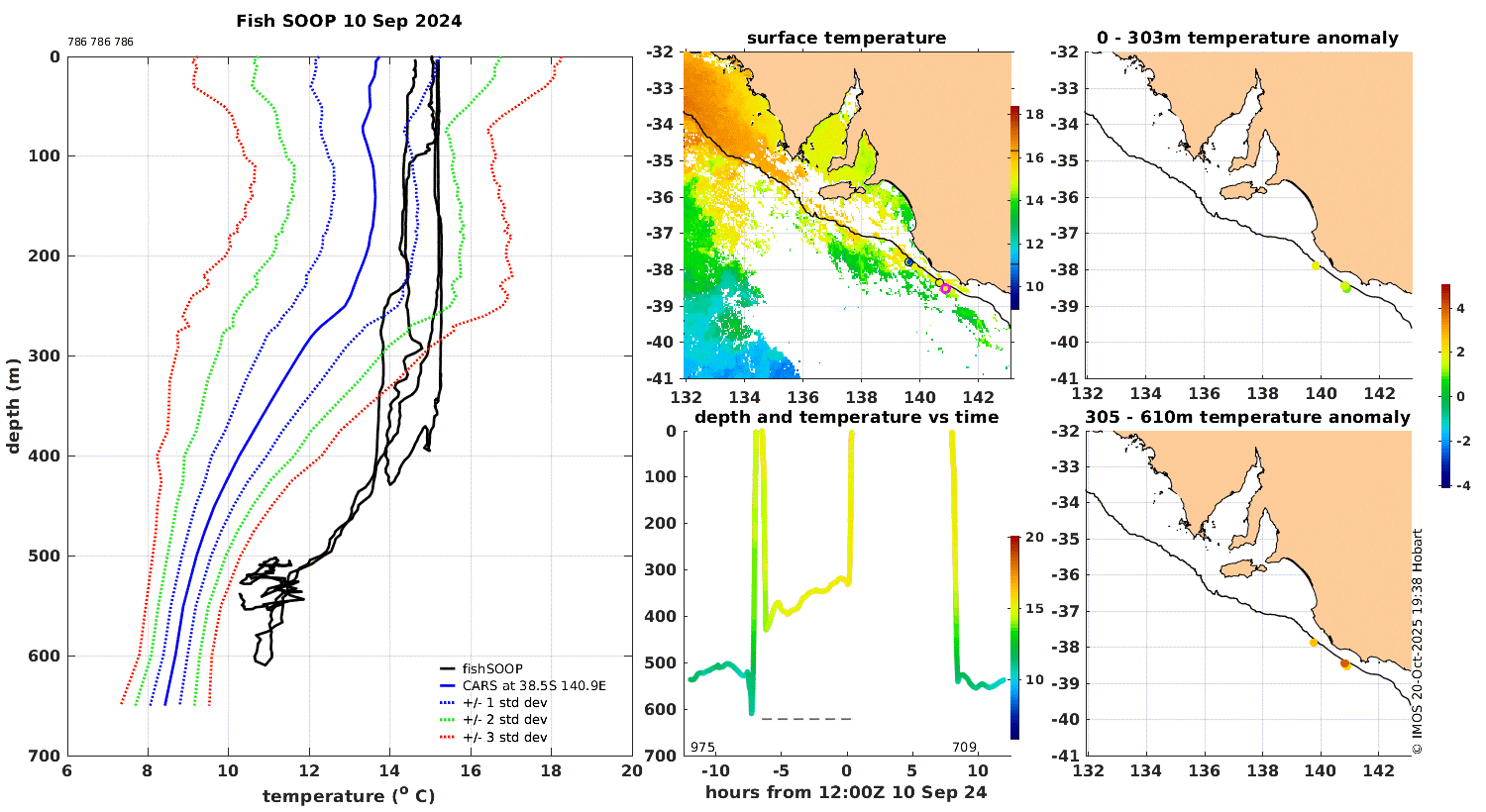
FishSOOP (Fishing Vessel as Ships of Opportunity Program) turns everyday fishing activity into ocean science fieldwork. By attaching small sensors to commercial fishing gear or equipment operated by citizen scientists, FishSOOP collects measurements of sea temperature and depth in coastal waters on and off the continental shelf.
All data are quality-controlled and made available open source through the Australian Ocean Data Network (AODN) in near real time. This provides unique insights into ocean conditions where it matters most to the fishing industry (where fishing occurs). FishSOOP bridges the gap between fisheries and science: supporting sustainable ocean use, improving climate and ecosystem understanding, and empowering communities with open data.
| data finder | data visualiser |
|---|---|
 |  |
The FishSOOP dataset comprises a large number of closely spaced deployments of temperature sensors, unevenly distributed but mostly over the continental shelf. The program started in 2021. To help you explore this dataset, we divide the data into daily, regional windows. To find data for your region(s) of interest, go to the data finder and navigate time (using the arrows or the calendar reached by clicking the year) until your region shows up as having data, which will be indicated by the regional boundary line being thick, and a count of the number of deployments that day being shown. Click anywhere within the box to see the temperature data. If the boundary is a thin line it means there were deployments at some point in the year, so clicking takes you to a calendar. A dashed bounding box means no deployments that year. These data finder pages also give a first glimpse of all the FishSOOP temperature data for the day, by showing the temperature anomaly observed by each deployment, averaged over 24h within depths of 0-50m. There are other ways to get to the data visualiser pages. One is via what used to be the Argo map page, now Argo+FishSOOP. Or, you may see FishSOOP symbols in the various satellite-focussed pages. Click to go to the corresponding FishSOOP data visualizer page. |
The data visualiser pages have five panels, all of which show the FishSOOP temperature data from all deployments within a region during a 24h period. The downside of this approach is that sometimes there is too much data for one plot. But we think that more often, this is outweighed by the value of comparing the observed data with neighbouring values.
Left panel: The FishSOOP temperature observations from all deployments that day are shown as black lines. To get a sense of how 'normal' these observations are, we include the climatological average profile (as a bold blue line) at the location of the deepest FishSOOP deployment, as well as the average plus 1, 2 and 3 standard deviations (as thin blue, green and red lines - see key). The climatology used is the CSIRO Atlas of Regional Seas (CARS 2009), which is now quite old. See below for more on the issue of old vs recent observations in the context of global warming.
|
These plots compare the entire FishSOOP data set with the CARS2009 climatology. The plot above is the Australia-wide summary, but there are also plots for 17 sub-regions reachable by links. For each region, the average difference between the FishSOOP observations and climatology (the 'anomaly') is shown for 8 overlapping layers, one of which is the whole water-column (nominally 0-1000m), shown above (at half size, click to expand).
Panel 1 Each dot on the map represents a single deployment of a FishSOOP sensor. Its location is the average for the deployment, while the colour represents the layer-average anomaly - the average of all measurements taken within a certain depth range. A few notes: 1) at this point we are treating short deployments the same as long ones (e.g. we have not calculated duration-weighted mean anomalies), 2) some deployments are obscured on the map because there are so many, so use the regional plots to see more individual deployments.
The title of the plot lists some statistics of the anomalies; the 5th, 50th and 95th centile values and the mean. These tell us the FishSOOP data set presently comprises 44,400 deployments in the Australian region. For the coldest (relative to historical data interpolated to location and day-of-year) 5% of these, the depth-averaged temperature was lower than climatology by 0.78 °C. Conversely, for the warmest 5% (the 95th centile), the depth-averaged anomaly was higher than climatology by 2.2°C. The median (50th centile) anomaly was 0.79° while the mean anomaly was 0.71°. The day to day variations are clearly large, and the mean is significantly non-zero.
Panel 2 Each dot represents a layer-mean anomaly from one deployment. It is plotted at the mean depth of all the data points within a depth-window (or 'layer'). So a deployment that went to 1000m and back at a uniform speed will be plotted at 500m. A deployment that spent most of the time at a fixed depth is plotted at that depth. The average of the layer-average temperature anomalies across all deployments is shown by the horizonal position of the red line. The vertical extent of these red lines shows the depth-window of the layers, which overlap.
Panel 3 shows that the slow temporal variability of the anomalies did not exceed the time-mean during the FishSOOP program. (To do: add a line showing the long period change)
Conclusion The aim of the CARS2009 climatology was only to characterize the mean and seasonal variation of the three dimensional ocean - not the trend. But since it was based on ocean observations made exclusively before about 2008, it can be thought of as representing the observed ocean state from two to several decades ago. If we interpret the mean anomaly of the FishSOOP observations (0.7°) as being due to a change over 4 decades, the average rate of change is therefore 0.17°/decade. This is consistent with many published estimates of the average rate of temperature change in the upper ocean. The lack of strong vertical gradient (down to about 500m) of the FishSOOP anomalies is also consistent with the findings of Roemich et al. (2015) who analysed Argo data. We therefore conclude that there is nothing suspicious about the average size of the FishSOOP differences from the CARS climatology, and look forward to including the FishSOOP data in multi-platform analyses of the state of the ocean, especially since the FishSOOP observations fill a gap between the blue-water coverage of Argo and coastal ocean sampling.
| Cold-core eddy off Byron Bay Cold core eddies are not always very cold at the surface. Oceanographers are more likely to infer their presence from seeing water circulating in a clockwise direction in an SST image (see top middle panel), or a depression of the sea level in satellite-based observations. The FishSOOP subsurface (60-120m) temperature anomalies in the centre of this eddy off northern NSW are about -2 °C (see bottom right panel), signaling an uplift of the isotherms by about 40m (see slope of blue line in left panel). The deep temperature minimum of 18.5 ° is about 1.5 standard deviations colder than the climatological mean, suggesting that this is a moderately strong eddy. |
 |
| Bass Strait Winter Cascade or Tasman Sea water? In July 2024, sensor 785 was deployed several times to about 430m at the upper continental slope off eastern Bass Strait. It was retrieved each time within about 7h. The deployment and retrieval temperature profiles were mostly similar but on both 20 July and 30 July, a difference of about 4 ° between the downward and upward measurements was recorded between 330m and 430m. What could have caused such big changes? One potential explanation is that the retrieval encountered some Bass Strait Winter Cascade water, but the deployment did not. Indeed, the SST images show that the surface water in Bass Strait was much colder (about 13 °) than the water off the shelf, so some of this cold (and therefore dense) water might have been falling off the shelf like an underwater waterfall. But why the change over just a few hours? The sensor depth was constant (see left and centre bottom panels), suggesting it was stationary on the bottom, and therefore that the path taken by, or the strength of, the Cascade was varying with time, perhaps due to the tide. Alternatively, maybe the cold water came from below rather than from above. The cold water sampled by sensor 785 was just 9 °C, somewhat colder than we expect to find in Bass Strait water. See this July 2021 glider mission, for example which found the water to be about 12.5 °C at all depths in the central basin. Where do we expect to find 9 ° water? An Argo profile on 12 July 2024 found it at about 500m in deep water east of Flinders Island, suggesting that what sensor 785 found was Tasman Sea water, temporarily upwelled at the continental slope, perhaps by an internal tide. Regardless of the cause, it is worth noting that this was such a large-amplitude event that some of the data (the warmest at depth) would have been flagged as bad if values outside 3 standard deviations from climatology were rejected. |
 |
| Swarm deployment of five sensors It is not that often that oceanographers deploy five sensors over 3h and 20km. But that's what this fisher did in deep water off Stockton Bight on 4 March 2024. The SST image suggests that these deployments were into the warm waters of the East Australian Current. But the sensors tell a different story. The surface waters were indeed warm (26 °C, 1 standard deviation above climatology) but this was just a very thin layer, just 10 to 20m thick. Beneath that warm water was water about 4 ° colder, which was what a sensor at the coast was finding from surface to 35m. This is not really surprising, but is interesting to see so clearly. |
 |
| Internal tides on the North West Shelf Sensor 445 was busy on 31 Dec 2024 documenting some large-amplitude internal tides north of Dampier on the North West Shelf. Six deploments to 70 to 100m were made over 24h, spanning a distance of about 20km. All recorded a surface temperature close to 31 °C and a bottom temperature of 27.5 °C. Where they differed was in the depth of the 29 ° isotherm, which varied from about 75m to 30m. The intervals between maxima and between minima are both about 12h, confirming that these are internal tides, which is what this region is known for in summer when shelf waters are stratified. |
 |
| South Australian algal bloom South Australia suffered a major Harmful Algal Bloom (HAB)that is thought to be due, at least in part, to a marine heatwave (MHW) that started around September 2024. Sensor 786 was deployed many times during the MHW, but mostly near the shelf edge off the Bonney Coast, between Portland and Robe, where it monitored the temperature of the South Australian Current. The 10 September 2024 deployment of sensor 786 found that water temperatures of the SAC were 2 to 5 degrees warmer than climatology, and below 300m, well in excess of climatology plus 3 standard deviations. It is hard to believe that this strong flow of warm water did not set the stage somehow (perhaps by suppressing the usual summer upwelling) for the waters near the Fleurieu Peninsula to become very hot in March 2025 when the HAB began. These observations by sensors 786 (and 421, which sampled inshore) are sure to be of value as oceanographers continue to learn more about the causes of this extreme event. |
 |
| The South Australian Current off Tasmania Much of the South Australian Current continues beyond the border with Victoria along the shelf edge west of Bass Strait then along the Tasmanian shelf edge where it is sometimes referred to as the Zeehan Current. Did the strong SAC observed by sensor 786 off the Bonney Coast (described above) show up off Tasmania as a strong Zeehan Current? Yes, according to sensor 785's measurements on 10 September 2024 at the shelf edge off Macquarie Harbour, which found near-normal temperature at the surface, but an anomaly of +3 ° at 400m, well outside of climatology plus 3 standard deviations. Notably, the temperature is completely isothermal from 0 to 400m. |
 |
| Cold water near bottom at 90m off Tiwi Island From 20 May to 2 July 2024, several FishSOOP sensors recorded the presence of a very cold layer of water in the bottom 10m over the outer continental shelf. This water was up to 7 °C colder (just outside 3 standard deviations) than the overlying water which was 29 °C (slightly warmer than climatology). The location of these observations was in 90m of water, NNE of Tiwi Island, not far from where IMOS has maintained a current meter mooring (NWSLYN, in 195m of water) since 2019. In June 2024, when FishSOOP recorded the cold layer, NWSLYN recorded temperatures of 16 ° to 18 ° at 154m as well as tidal period current velocities of about 0.2m/s in antiphase above and below 100m. These very different observing systems are therefore consistent and the picture that emerges is that internal tides are energetic at the NWSLYN site in June 2024 because the site is deep enough that the thermocline is near mid-depth. The FishSOOP observations, however, are in shallower water. Is the cold layer running up the slope like a wave coming onto a beach? Another question remaining is "why are the deep temperatures so much (about 10 °C) colder than those recorded by the ITFMHB mooring in a similar depth 250km to the WSW?" |
 |
Technical details of the FishSOOP program are documented by Lago, V., M. Roughan and S. Caon. (2025) IMOS Fishing Vessels as Ships of Opportunity (FishSOOP), Real-time Quality Assurance and Quality Control Practice Manual, Version 1.0. Integrated Marine Observing System. doi.org/10.26198/sp0r-p448. Possibly the most important detail documented in that report is that FishSOOP sensors are very accurate (0.05°C) and have a fairly fast response time (1s).
OceanCurrent does not perform any additional editing of the data set that is available to all at the IMOS data server. We show all data that are flagged as good (flag value 1) in the FV001. Data flagged otherwise (including 2='potentially correctable') are not shown (they are not many).
Stay in the loop! Subscribe to the FishSOOP newsletter
20 October 2025: First exposure draft for SC approval. (Accessable only to those who have been given a URL by email)
To Do